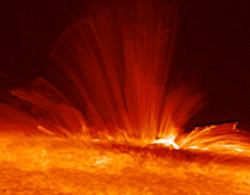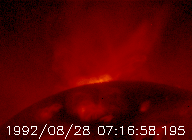For you solar observing fans, enjoy the beauty. Over the years both the public and astronomers alike have witnessed the Sun’s volatile and ever-changing atmosphere. Before our eyes huge geysers of hot gas spew into the solar corona at tens of thousands of km per hour. Every few minutes they erupt and reach dynamic proportions. Now a team of scientists have used the Hinode spacecraft to find the origin and progenitor of these fountains – immense magnetic structures that thread through the solar atmosphere.
Today at the Royal Astronomical Society National Astronomy Meeting in Belfast (NAM 2008), team leader Dr. Michelle Murray from the Mullard Space Science Laboratory (MSSL, University College London) presented the latest results from Hinode spacecraft combined with computer emulated solar conditions. Since its launch in October 2006, scientists have been using Hinode to examine the solar atmosphere in extraordinary detail. One of it’s premier instruments is the Extreme Ultraviolet Imaging Spectrometer. The EIS generates images of the Sun and gives information on the speed of the moving gases.
At the core of the solar magnetic field, immense jets of hot gas are forced to the surface through increases in pressure. Just like an earthly geyser, when the pressure releases the gases fall back towards the Sun’s surface. But what causes the pressure? Unlike the volcanic activity that drives the terrestrial phenomena, solar fountains are caused by rearrangements of the Sun’s magnetic field, a continual process that results in looping cycles of increasing and decreasing pressure.
“EIS has observed the Sun’s fountains in unprecedented detail and it has enabled us to narrow down the fountains’ origins for the first time”, comments team member and MSSL postgraduate student Deb Baker. “We have also been able to find what drives the fountains by using computer experiments to replicate solar conditions.”
 The sun-observing Hinode satellite is now in a sun-synchronous orbit, which allows it to observe the sun for uninterrupted periods lasting months at a time. Using a combination of optical, EUV and X-ray instrumentation Hinode will study the interaction between the Sun’s magnetic field and its corona to increase our understanding of the causes of solar variability.
The sun-observing Hinode satellite is now in a sun-synchronous orbit, which allows it to observe the sun for uninterrupted periods lasting months at a time. Using a combination of optical, EUV and X-ray instrumentation Hinode will study the interaction between the Sun’s magnetic field and its corona to increase our understanding of the causes of solar variability.
“The computer experiments demonstrate that when a new section of magnetic field pushes through the solar surface it generates a continual cycle of fountains”, explains Dr. Murray, “but new magnetic fields are constantly emerging across the whole of the solar surface and so our results can explain a whole multitude of fountains that have been observed with Hinode.”


Amazing footage.
Am not sure as to the computer-emulations. Are these simulations based on existing data or incoming information from Hinode, or something completely different?
Greetings, Alphonso!
The animated clip at the lead of the article was taken with another Sun-orbiting observatory, Yohkoh. The second image, inserted into the story, is an outstanding shot take with Hinode itself.
It is my understanding the computer emulations are done with Hinode data and try to replicate the conditions.
I’ve also added an clip above for “fountains observed with Hinode” that’s an quicktime movie. Thanks for your interest and please let me know if the link to the Hinode movie doesn’t work properly.